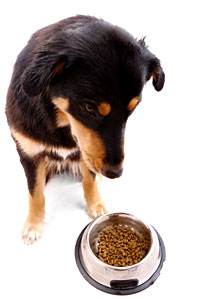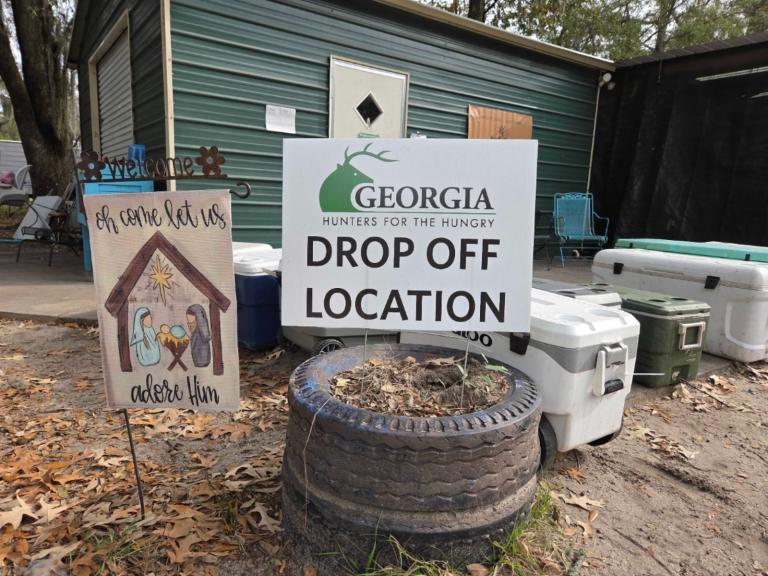In Checkout Line, Lou Bendrick cooks up answers to reader questions about how to green their food choices and other diet-related quandaries. Lettuce know what food worries keep you up at night.
—–
Dear Grist,
I eat organic food; should my dog? What’s the deal with organic dog food and what’s the problem with conventional dog food anyhow? And most importantly, does organic dog food taste better? Not that my dog has ever been too picky about what he eats, but I’ve always wondered when I dump the same dry kibble in his bowl day after day if he actually likes it.

Best regards,
Tara
Dear Tara,
Are you familiar with the work of artist Stephen Huneck? In his book, The Dog Chapel, there is a woodcut print of a human hand reaching toward a grocery store shelf stocked with “The Really Expensive Dog Food.” The accompanying text reads, “Be good to your friends.”
Hats off to you for being good to your friend by at least considering the organic kibble. Your friend, after all, watches your every move with moist, adoring eyes, guards your car stereo with his life, and keens when you go to the movies. And what is the reward for this undying loyalty? Most likely, a couple of tethered walks each day, and kibble, ad infinitum.
The problem with conventional dog food is that it could contain cheap, unhealthy ingredients — or even deadly ones. Last year, there was a massive pet-food recall after a Chinese manufacturer added melamine, a toxin, to pet food, which killed an untold number of beloved companion animals. As nutritionist Marion Nestle pointed out in her recent Grist interview, pet-food regulation and labeling are sorely lacking, even after this incident.
And, just to prove that the pet-food industry is not headed toward a reformation, that group is now considering the use of distiller grains (a byproduct of ethanol production) that could potentially contain toxins.
Toxins aside, commercial pet food legally may contain such unsavory things as newspaper, feathers, high-fructose corn syrup, cancerous or diseased animal tissues, bovine fetal tissue, and “glandular waste.” According to an article on Dr. Andrew Weil’s web site, the animals rendered into many pet foods are classified as “4D”: Dead, Dying, Diseased, or Disabled (aka “downer”).
In short, the commercial pet-food industry hasn’t quite figured out how to work nuclear waste into dog food, but it does seem to have a penchant for icky byproducts. Still, does these mean that you need to feed your dog organic kibble?
The first thing to figure out is what you’re getting when you reach for organic on the pet-food aisle. According to veterinary nutritionist Dr. Lisa Freeman, professor of clinical sciences at the Cummings School of Veterinary Medicine at Tufts University, there is no federal or international standard for what qualifies as “organic” pet food.
“While some foods are made with great care and high standards,” Freeman told me by email, “using the term ‘organic’ is a marketing strategy.” Freeman encourages pet-owners to buy their dog food from a well-known, reputable company that they trust and one that has undergone feeding trials with the Association of American Feed Control Officials. (Check the label for this imprimatur.)
But wait: There’s more work for you to do to find high-quality pet chow (and hey, isn’t that lavish greeting you get from your dog after a long day of work worth a little work?). Freeman advises that you find a company that employs at least one full-time nutritionist, has a research and development department, and conducts ongoing research on the firm’s foods to continue to improve them.
“Companies should also have high-quality control standards for their ingredients, the food’s shelf life, and their ability to detect and respond to a problem with their end-product,” she writes. “If you can’t find this information on the internet, call the company.”
Now, just to complicate things, and with apologies to Stephen Huneck, the best dog food doesn’t necessarily mean the most expensive one. “I encourage pet owners to be informed consumers when it comes to their dogs’ food,” Freeman advises. “Having high standards doesn’t necessarily mean that the price of dog food is high, and not all expensive pet foods are formulated using these standards. Read the label carefully!”
Most important, though, your dog does have to like his food. Because your dog is “not too picky,” you might not be able to tell if his organic kibble tastes better to him than the conventional stuff. My curiosity aroused, I decided to do a taste test using an expert panel. I offered this panel side-by-dishes of kibble: Castor & Pollux Organix Canine Formula, which contains organic free-range chicken, barley, brown rice and flax seed; and Purina Dog Chow, which among other disheartening ingredients contains “animal digest” — animal tissues broken down with chemicals.
The test results: Our expert panel, perhaps intoxicated by the break in kibble monotony, devoured both bowls (starting with the Purina) with equal vigor. But then, our panel is just a dog.
For you, Tara, I also personally tasted both kibbles (note to self: Demand hazard pay from Grist). The Organix Canine Formula kibble tasted like a really earthy health food store cracker (pass the tahini dip). The Purina Dog Chow tasted blander than it smelled, but like rancid fat nonetheless.
Bottom line: Your dog, being a dog, may have an undiscriminating if not ghoulish palette. My late, long-lived dog ate mostly organic kibble for many of his 13 years, but much preferred putrid things he found in the woods, which were still probably healthier than “animal digest.”
I think it’s safe to say that your buddy will be healthier if he eats high-quality organic food and you’ll get to support the values you’re already choosing for yourself by purchasing organic food — avoiding planetary and corporeal pollution from pesticides, antibiotics, synthetic fertilizers, growth hormones, GMOs, etc.
I’m feeling the strong urge to play with a squeaky toy, so I must go now. Give your friend a pat on the head for me.
Sincerely yours,
Lou Bendrick


